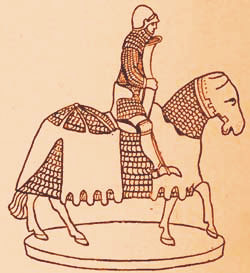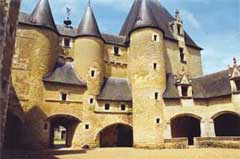Barding - The Armored Defence of the Horse
Barding, or the horse armor, must be mentioned in any history of the knights’ armor, given the huge importance the war horse had in a knight’s life. Whether equipped with the chain mail armor, or completely clad in plate, the knight was entirely dependent on his horse, both in real warfare and in tournaments. The war horse, named Destrier, had to be protected as much as possible, the same as his master.

Barding: Scale Armor and Trapper
Ivory Chess Piece, 14th Century
The Bayeux tapestry does not mention any armor being used for the Normans’ horses. In his chronicle “Roman de Rou”, Wace is mentioning Duke William’s horse as being defended by armor, “covert de fer.” However, he wrote in the second half of the 12th century, and, as with all Medieval chroniclers, he portrayed his characters in the dress of his time.
Chain mail armor for horses was known as early as the Roman times, as shown on the Column of Trajan, but in the Middle Ages it does not seem to have been in common use before the 13th century.
Barding developed along similar lines with the knights armor.
Paintings executed about the year 1237 are showing a quite inconvenient trapper of chain mail. It is doubtful that that particular model was in general use, as the horse could barely walk, let alone to trot or to gallop.
A much lighter textile trapper was used more for display and ornament, however these garments were designed for the same purpose as the knight’s surcoat: to protect the armour from wet.
When their owner died, the rich trappings were donated to churches, where they were used as altar hangings. The relation worked both ways, meaning that if, for some reason, the trappings were required, the churches were asked to provide them.
As the man was in some cases defended by quilted garments, so the horse could wear a quilted trapper. Matthew Paris, when describing the Battle of Nova Croce in 1237, writes that Milan raised an army which was using iron-clad horses. And an ordinance of Philip the Fair, dated 1303, required that owners of certain estates should provide at least a man-at-arms mounted on a horse wearing armor or quilted defences.
The caparisons first appeared on Royal seals under Edward I. There are also mentions of a rigid horse armor in the Windsor Roll. We learn that the head piece was made probably of cuirbouilli, as suggested also by the image presented here. The breast plate could be of cuirbouilli as well.
The back of the horse was protected by the crupper, made of several pieces riveted or hinged together. The root of the tail was protected by a tubular plate called the gardequeue. To prevent chafing, the plates were lined with leather or wadded with cotton.
In the 15th century, the horse was protected with plate armor, the same as the knight.
Barding was very close to the human armor even in decorations, delicate lines being embossed in the metal surface in the same way that the knight’s armor was treated.

